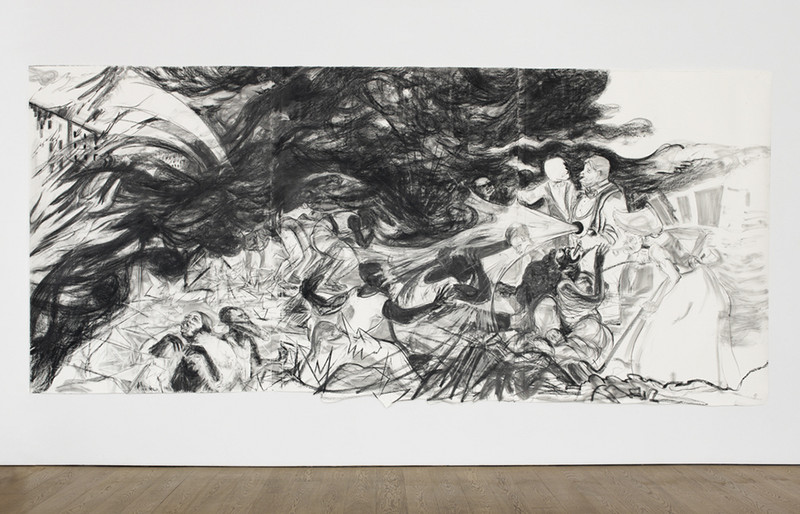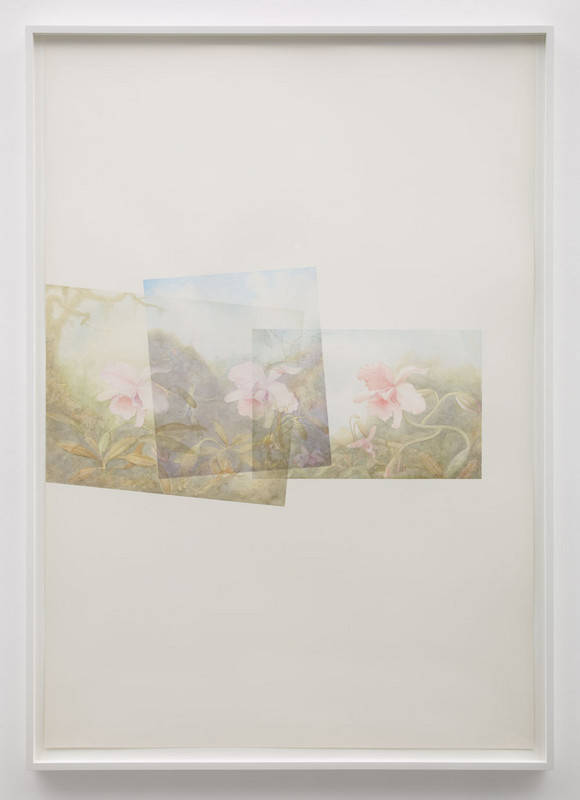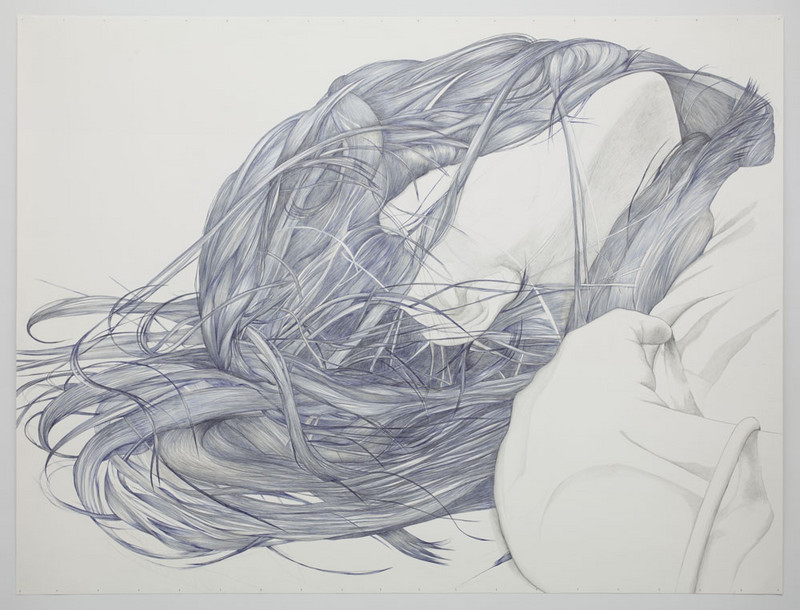Works on Paper
02 Sep - 04 Oct 2014

© Jorge Queiroz
Shape of things 1, 2014
Watercolor, pencil, color pencil, vinyl gouache, oil pastel on paper
69.25 x 56.75 inches / 175.9 x 144.1 cm
Shape of things 1, 2014
Watercolor, pencil, color pencil, vinyl gouache, oil pastel on paper
69.25 x 56.75 inches / 175.9 x 144.1 cm

© Kara Walker
Sketch for an American Comic Opera with 20th century Race Riots, 2012
Pastel and graphite on paper
3 parts:
99.25 x 216.75 inches, overall, framed
252.1 x 550.5 cm
Sketch for an American Comic Opera with 20th century Race Riots, 2012
Pastel and graphite on paper
3 parts:
99.25 x 216.75 inches, overall, framed
252.1 x 550.5 cm

© Marc Handelman
Close-up, No People, Scenics, 2014
Watercolor on paper
59 x 48.875 inches / 149.9 x 124.1 cm
Close-up, No People, Scenics, 2014
Watercolor on paper
59 x 48.875 inches / 149.9 x 124.1 cm
WORKS ON PAPER
Antony, Jorge Queiroz, Kara Walker, Marc Handelman, Marlene McCarty
2 September – 4 October 2014
Sikkema Jenkins & Co. is pleased to present a group exhibition of works on paper by five artists represented by the gallery: Antony, Marc Handelman, Marlene McCarty, Jorge Queiroz, and Kara Walker. The exhibition will present artists whose oeuvres and use of paper are at once radically diverse yet at points thematically intertwined. The works on view include preparatory sketches that give insight into the artist's process, as well as finished works and series, which allude to prior projects and artistic concerns.
Alongside a critically acclaimed musical career as a singer and composer, Antony has created a body of work that includes drawings, collage and sculpture. His work on paper is often delicate and intimate in scale, made from found, and sometimes ephemeral materials that reference the natural world and our relationship to it.
Marc Handelman's new large-scale watercolors explore the unique repetition of motifs in the oil paintings of 19th century landscapist Martin Johnson Heade. Continuing a long-standing critical interest in landscape and image culture, Handelman has painted numerous layers, superimposing several works of Heade's in which the uncanny figure of the same orchid flower functions as a matrix image whose alignments reveal different compositional conventions by their shifting frames. Handelman sees this use of repetition as a prescient nod to today's "image-ecology," i.e. the proliferation and pervasive use of stock images.
Marlene McCarty's drawings represent the final gesture to her earlier body of work known as the Murder Girls, a series of monumental portraits of teenage girls who had committed murder. Often working with no. 2 pencils and ballpoint pens on paper, McCarty's highly detailed imagery can be provocative, unsettling, and sexually explicit, while undercut by a distinctive feminist voice and a career largely devoted to artistic political activism, as related to her work with 1980s AIDS art/activist collective Gran Fury.
Jorge Queiroz's large-scale drawings suggest surrealist landscapes or dreamscapes in vibrant color and amorphous forms. He envisions the viewer tracing a narrative between these imaginary worlds, with figures and scenes "melting into the other, from one work to the next.”
Working at the intersection of race, sexuality, and gender, Kara Walker has utilized cut-paper silhouettes to distort, expose, and locate the surreality within America's history of slavery. In a departure from the most well-recognized and idiosyncratic imagery of her career, Walker's Sketch for an American Comic Opera with 20th century Race Riots has a more direct relationship to the artist's hand, with a greater sense of chaos, chance, and movement. A monumental diptych in three parts rendered in pastel and graphite, the work includes the 19th century Southern characters often seen in her silhouettes — the masters, slaves, and onlookers – now given faces and expressions drawn in loose, rough strokes, and in doing so are brought into the light for us to engage with in new ways.
Antony, Jorge Queiroz, Kara Walker, Marc Handelman, Marlene McCarty
2 September – 4 October 2014
Sikkema Jenkins & Co. is pleased to present a group exhibition of works on paper by five artists represented by the gallery: Antony, Marc Handelman, Marlene McCarty, Jorge Queiroz, and Kara Walker. The exhibition will present artists whose oeuvres and use of paper are at once radically diverse yet at points thematically intertwined. The works on view include preparatory sketches that give insight into the artist's process, as well as finished works and series, which allude to prior projects and artistic concerns.
Alongside a critically acclaimed musical career as a singer and composer, Antony has created a body of work that includes drawings, collage and sculpture. His work on paper is often delicate and intimate in scale, made from found, and sometimes ephemeral materials that reference the natural world and our relationship to it.
Marc Handelman's new large-scale watercolors explore the unique repetition of motifs in the oil paintings of 19th century landscapist Martin Johnson Heade. Continuing a long-standing critical interest in landscape and image culture, Handelman has painted numerous layers, superimposing several works of Heade's in which the uncanny figure of the same orchid flower functions as a matrix image whose alignments reveal different compositional conventions by their shifting frames. Handelman sees this use of repetition as a prescient nod to today's "image-ecology," i.e. the proliferation and pervasive use of stock images.
Marlene McCarty's drawings represent the final gesture to her earlier body of work known as the Murder Girls, a series of monumental portraits of teenage girls who had committed murder. Often working with no. 2 pencils and ballpoint pens on paper, McCarty's highly detailed imagery can be provocative, unsettling, and sexually explicit, while undercut by a distinctive feminist voice and a career largely devoted to artistic political activism, as related to her work with 1980s AIDS art/activist collective Gran Fury.
Jorge Queiroz's large-scale drawings suggest surrealist landscapes or dreamscapes in vibrant color and amorphous forms. He envisions the viewer tracing a narrative between these imaginary worlds, with figures and scenes "melting into the other, from one work to the next.”
Working at the intersection of race, sexuality, and gender, Kara Walker has utilized cut-paper silhouettes to distort, expose, and locate the surreality within America's history of slavery. In a departure from the most well-recognized and idiosyncratic imagery of her career, Walker's Sketch for an American Comic Opera with 20th century Race Riots has a more direct relationship to the artist's hand, with a greater sense of chaos, chance, and movement. A monumental diptych in three parts rendered in pastel and graphite, the work includes the 19th century Southern characters often seen in her silhouettes — the masters, slaves, and onlookers – now given faces and expressions drawn in loose, rough strokes, and in doing so are brought into the light for us to engage with in new ways.


